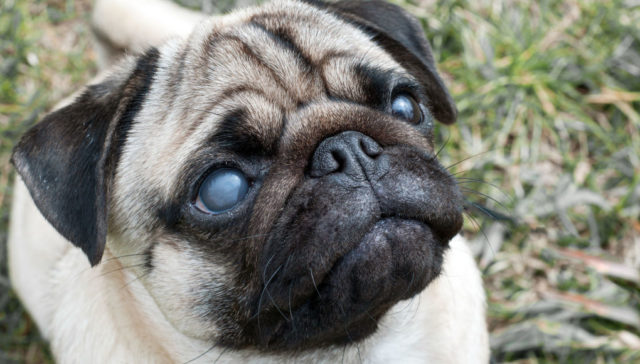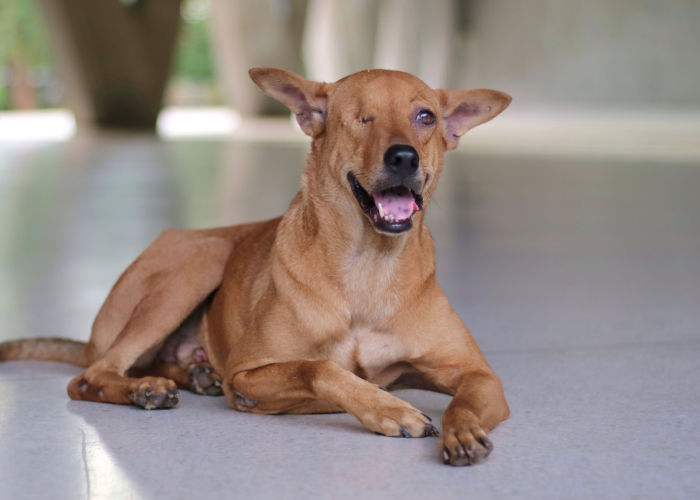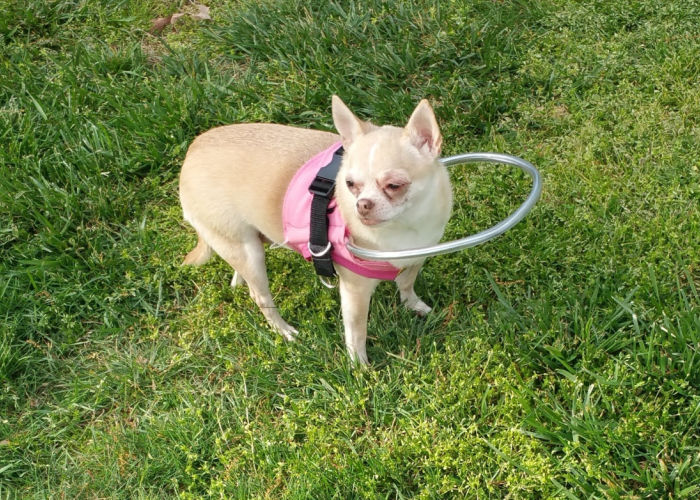
Table of Contents
LEARNING HOW TO CARE FOR A BLIND DOG may seem to be a daunting task in the beginning.
Having pups under your wings is a responsibility in itself—more so when they have extra needs, right?
But don't worry, because having a visually impaired dog—whether newly blind or caused by old age—shouldn't mean the end of fun times together.
Blind dogs can still enjoy the quality of life that they deserve with your love and support.
In this article, let us give you tips on how to care for a blind dog, how to help them not bump into things (which can happen a lot in the beginning!), and how to live and work with a blind dog.
Caring for a Blind Dog: Causes of Blindness
There are many reasons why dogs go blind—it could be caused by a disease, genetics, accidents, or old age.
Some of the common eye diseases senior dogs get are glaucoma and cataracts.
Just like with humans, elderly dogs are also predisposed to these conditions as their vision deteriorates over time.
However, there are conditions that can cause sudden and irreversible blindness, like SARDS or Sudden Acquired Retinal Degeneration Syndrome.
And what's worse is it can happen without any warning or physical indications at all.
Genetics also play a big role in a dog's eye health.
One of the most common inherited eye diseases for dogs is Progressive Retinal Atrophy, where the retina of the eye gradually degrades over time.
Because of genetics, some breeds are also predisposed to blindness.
French Bulldogs, Shih-Tzus, and Pugs, among others, are more prone to developing visual impairment as compared to others.
In fact, experts are now saying that flat-faced dogs are becoming more susceptible to eye problems not only because of their genes but also because of overbreeding.
Types of Blindness in Dogs
Depending on your dog's condition, it can cause complete, partial, or intermittent blindness.
As the name suggests, complete blindness is when your dog can't completely see anything anymore, even light.
Partial blindness, on the other hand, is when a dog has cloudy vision and is still able to see shapes and lights. It can also mean he is blind in only one eye.
There are also circumstances where intermittent blindness happens.
It's when their blindness comes and goes sometimes randomly, sometimes only at night or in darker places.
Common Signs of Blindness in Dogs
For the most part, there are indicators and warning signs you can check to alert you about your dog's eye condition.
Here are the common physical and behavioral changes that happen to a possibly visually impaired dog.
Physical Signs
- Obvious cloudiness in both or each eye
- White spots in the eye
- Pupils don't dilate normally when lit
- Enlarged pupils
- Eyes are red, puffy, or swollen
Behavioral Signs
- Bumping into things frequently
- Constant pawing at the face
- Signs of anxiety or hesitation when in new places
- Anxiety when approached by people, either by someone familiar or a stranger
- Confused, dazed, or easily startled
- Acting afraid to move
- General clumsiness
- Apprehensive during play
- Unable to find water, food, and toys
- Not wanting to go outside
- Depression
- Sleeping more than usual
- Excessive thirst
- Unable to catch tossed treats
- Less interest in activities they used to get excited about
- Not making eye contact
- Unwilling to go up or down stairs or jump onto furniture, which they normally did
But don't jump to conclusions just yet!
If you're observing one or a couple of these possible signs on your dog, it's still best to seek professional advice for proper diagnosis and treatment.
How to Care for a Blind Dog
Good thing that dogs don't rely only on their sense of sight in navigating around.
They also have super auditory (hearing) and olfactory (smelling) senses that allow them to still be instinctive of their surrounding.
But that's not to say we should leave them to their own devices.
As dog owners, it's our responsibility to make sure that they are comfortable, safe, and healthy at all times.
Plus, we want them to still live their best life, right?
Here are a couple of things we can do as fur parents to care for a blind dog.
Create a Safe Space for Your Blind Dog
The same way you would baby-proof a house, you should puppy-proof it upon the arrival of a new furry family member. But this time, you would want to ‘blind puppy proof' it.
This means no redecorating, no adding of furniture, and no moving things around the house.
Leave everything as is because that's the familiar environment for your dog. Remember that they can't see, and it will make it only difficult for them to adjust if ‘obstacles' in the house are constantly moved.
Even stray clothes, shoes, or socks in the hallway should be kept away at all times! Any unfamiliar objects lying around, even how harmless they can be, can still cause blind dogs anxiety.
Food and water bowls should also always be kept in exactly the same spot.
If your dog has intermittent or partial blindness, keeping a well-lit stairway can help them still go up and down. There are also glow-in-the-dark tapes like this that you can use to mark potential hazards like table corners or a step in the doorway.
It's also best to put safety gates on stairs to prevent them from possibly falling over.
Remember that the safety of our blind dog should be our topmost priority.
Set up Sound, Scent, and Touch Cues
It's time to take advantage of your blind dog's other senses this time. However, this may be easier when your dog still has partial sight
You can leave different distinct smells in every different part of the house, like vanilla or lavender essential oils on your doorway, the kitchen rug, or near their dog bed.
Placing wind chimes by the door will also alert them that they are nearing outside the house.
Teaching them verbal cues such as “left” or “right” will also help you help them navigate their surroundings.
Using textured mats and rugs will also help mark different locations for your dog. You can place one near their food and water bowls and another near windows or glass partitions to prevent them from walking into it.
Also, it's gonna be better and easier to train them to recognize these cues when they still have even just partial vision.
Keep them away from Outside Dangers
While it's important to slowly reintroduce blind dogs to the outside world after losing their vision, you also have to make sure that they are safe and sound from any potential danger.
Oncoming traffic, an aggressive-looking dog, or any potholes or sharp objects outside can harm them if not avoided.
You will be your blind dog's eyes from now on, so you'd have to be extra observant in your surroundings when walking with them.
Remember that dogs love routine, so walking the same path every time will help them become familiar with it and know which directions to take.
There are also available accessories for blind dogs online that you can use, like this blind dog leash that lets others be aware of your dog's condition.
You can also partner this with a harness and halo to prevent them from bumping into obstacles accidentally.
The verbal cues you taught him will also be very helpful in keeping them safe outdoors.
Also, make sure that they are equipped with any identification, like a collar tag or microchip containing your latest contact information in case something unfortunate happens.
Supervise Interaction with Unfamiliar People or Animals
Because blind dogs can be highly anxious and extremely nervous, make sure you supervise their interaction with other people or pets.
Keep a close eye and make sure your presence is known to them when around unfamiliar individuals.
Let your visitors know of your dog's condition and not sneak behind or suddenly pet them.
If possible, let them wear bells around their ankles or talk first before approaching your dog.
Slowly introduce them to the unfamiliar and let them take their sweet time instead of forcing them into it.
Keep Doing Enrichment Opportunities
Just because they are visually impaired doesn't mean blind dogs don't like to have fun. They certainly still can!
Physical activities are still just as important to them to keep them fit and healthy.
Sure, there will be some limitations, but that doesn't mean it can't be fun and enjoyable for you both.
Playing with a Blind Dog
Blind dogs will use their other senses in playing, so making them fetch frisbees may not be the best activity.
Instead, use toys that will stimulate their other senses, like squeaky toys or those with bell sounds.
There are even sensory toys that stimulate their sense of smell and taste, like this beef-scented and flavored rubber ball.
Training with a Blind Dog
Nothing much is different in training blind dogs except, of course, their inability to respond to visual cues.
Verbal cues will still work best in teaching them different tricks and commands.
You can also use the lure-and-reward technique followed by a marker signal that they can hear or feel to let them know they're doing well.
Training them despite their condition will exercise them physically and mentally. It will also help build self-confidence and resiliency.
Here we have the top 21 must-know dog training tips to help you get started.
You can also check out this video from The Battersea Way for more reference!
Sports for Blind Dogs
Yes, blind dogs can still do sporting events!
The American Kennel Club has several events that active blind dogs can participate in, like the AKC Scent Work, where their exceptional sense of smell will be the star of the show.
They are also welcome to try the Canine Good Citizen (CGC) program, other trick dog competitions, and therapy dog works.
Always Be Patient
You might be tired of hearing or reading this, but it's true! Patience is the ultimate tool you'll need in taking care of a blind dog.
Best believe that it'll take time, work, and effort. You'd be frustrated at times, sure.
But remember that your dog is also trying his best to learn.
Giving them extra love and patience will go a long way in making sure they live the best quality of life they deserve despite their condition.
FAQs on How to Care for a Blind Dog
What do I need for a blind dog?
There are several tools and accessories you'd need in training and caring for a blind dog.
Some of our recommended stuff you can check out for your blind dog are:
- Muffin's Halo
- Walkin' Halo Blind Dog Harness
- Ocu-GLO Vision Supplement
- STELLAIRE CHERN Snuffle Mat
- GoTags Pet ID Tags for Dogs
- Pet Qwerks Talkin Babble Ball
- American Kennel Club Anti-Anxiety and Stress Relief Calming Coat for Dogs
You can get more details in this article.
Can blind dogs be left alone?
Just like the others, blind dogs can also be trained to be left alone by themselves.
Take note: they have to be trained to get used to being left alone to their own devices. Otherwise, it's easy for them to develop separation anxiety.
There are also alternatives if you yourself are unsure of leaving them alone at home.
You can check them in dog daycares that cater to blind dogs to make sure they will be cared for while you're away for the day.
It will take time and patience for both of you to properly adjust before he's confident enough but trust that he'll get there.
What activities can you do with a blind dog?
You'd be surprised that there are lots of activities you can enjoy doing with your blind dog!
Some of the fun things you can do with them are play tug of war or play fetch with a talking ball.
Of course, just make sure you do this in a controlled environment, one that they're very much familiar with, like your backyard.
If your blind dog is only comfortable playing inside the house, then walking them on a treadmill can make sure you still sneak in a bit of exercise, which they need to be fit.
How to Care for a Blind Dog: Final Thoughts
If you're a dog parent, it's important to know and understand how to care for a blind dog early on.
As we know, there are many factors that can affect a dog's eye health, and one of them is old age which is inevitable.
Just remember that blindness in dogs isn't, and shouldn't, be a death sentence.
There are many things that we can do to help them maximize their potential and live the best quality of life they deserve!
















